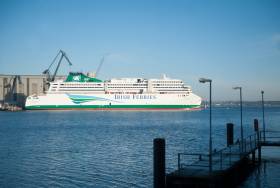Displaying items by tag: Departs Shipyard
#FerryNews - While Irish Ferries flagship Ulysses is currently out of service, Afloat also reports on the much delayed €150m cruiseferry W.B. Yeats which is finally to begin sea-trials in the Baltic Sea, writes Jehan Ashmore.
W.B. Yeats last night departed the shipbuilder, Flensburger Schiffbau-Gesellschaft (FSG) in Flensburg. The shipyard located close the Danish border, experienced delays in the fitting out of interior components for public areas and on the electrical system installation in the hull and deckhouse.
According to FSG, back in June, the shipyard stated that entry into service is now planned for September. This final stage of construction work subcontracted by FSG, was further pushed back and so delayed again the debut of the 1,885 passenger/1,200 vehicles capacity cruiseferry which has accommodation in 435 cabins.
The largest ferry that is to connect Ireland-France, W.B. Yeats at 54,985 gross tonnage, was originally to start service on 12 July, firstly on the Dublin-Cherbourg route followed in September by a transfer to the Holyhead route in the winter months. As during that timeframe, ropax ferry Epsilon maintains the year round operated link connecting the Irish capital and France.
The postponement of W.B. Yeats by FSG, left Irish Ferries in a difficult situation that led to major disruption as sailings were cancellations during the peak-season. This involved affecting to varying degress the travel plans of thousands of holidaymakers.
Passengers were given the option of travelling on the company's more established continental routes through Rosslare served by cruiseferry Oscar Wilde which Afloat reported today has been operating this month both to Holyhead and Cherbourg on routes based out of Dublin.
Oscar Wilde since yesterday has begun covering the Rosslare -Pembroke route while routine cruiseferry Isle of Inishmore took over the sailing roster of Ulysses. The flagship as alluded in the introduction is off service from the Dublin-Holyhead route due to technical reasons.





























































